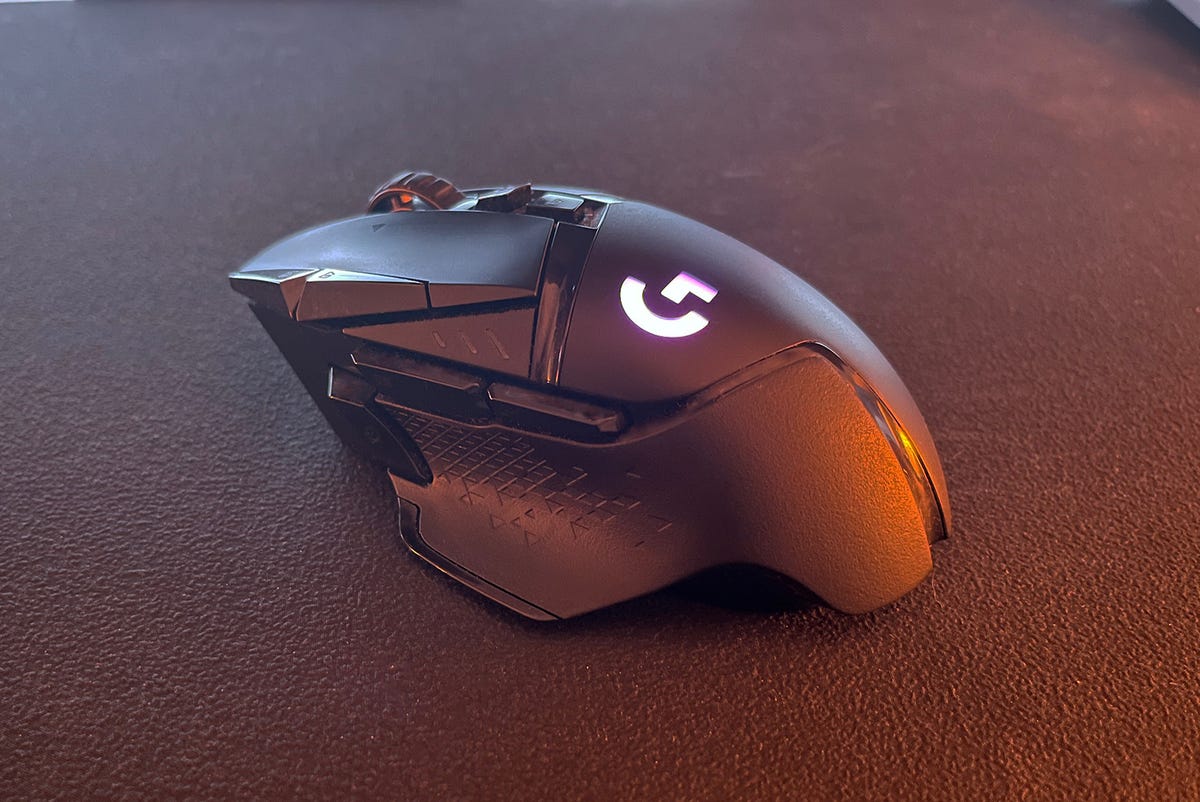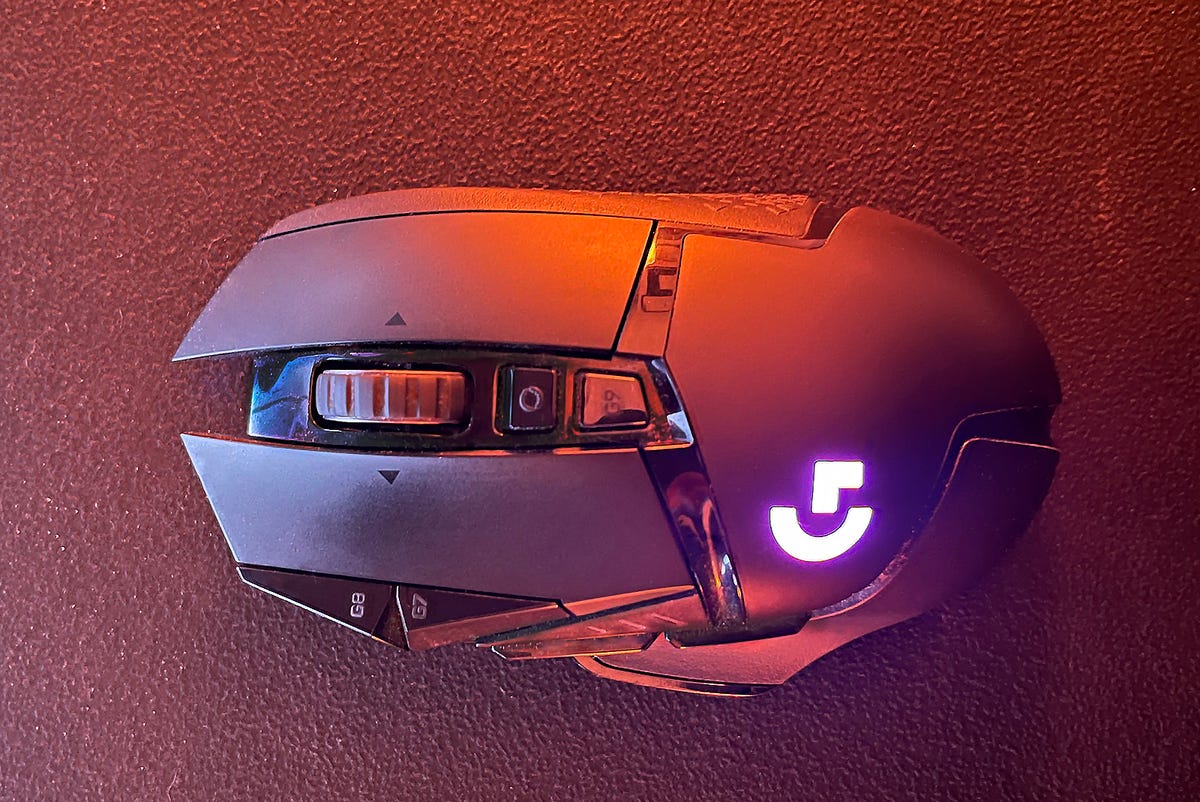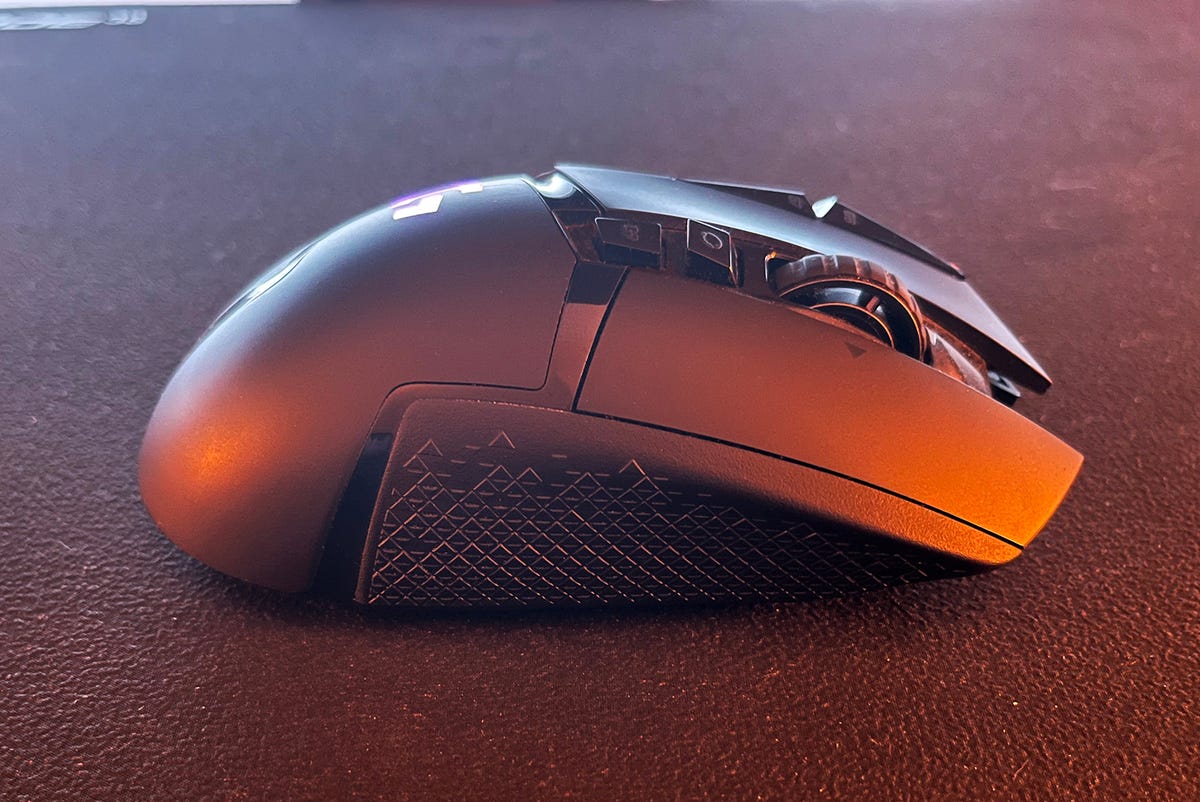Logitech G502 Lightspeed review: The Swiss Army knife of mice | ZDNet
If it had been released even a few years earlier, the Logitech G502 would easily be among the best mice available for gamers of any stripe. As things stand, it’s a much harder call, and one that’s dependent on what genre of games you play most often and what you prioritize when shopping for a mouse.
This reality isn’t so surprising when you consider the fact that the G502 Lightspeed is almost physically identical to the G502 Proteus Core, a mouse that was originally released all the way back in 2014. At the time, the original G502 was one of the best mice available, period. Today, even with a slew of tweaks and improvements, its successor is still a more niche product, primarily because of the lingering influences of its ancestry.
Despite all of that, the G502 Lightspeed and its corded cousin,
the G502 Hero
, remain some of the most popular mice out there. In fact, as I write this review, the G502 Lightspeed is once again sold out on Logitech’s own web store. So, what is it that makes this design so lasting and so able to maintain a user base, even at a time when many of its specifications should put it out of the running? Let’s take a closer look at one of the most popular, and in many ways most controversial, gaming mice available today.
Like
- Sturdy, versatile build adept at handling work and play
- Powerplay compatibility with wireless charging and docks
- Comfortable, ergonomic shape
- Switchable Hyper-fast scrolling
Don’t Like
- Almost twice as heavy as most modern gaming mice
- Heavy use of rubber that can wear away of the long term
Form factor and build
The G502 Lightspeed launched as a 114g mouse at a time when most manufacturers, including Logitech itself, were attempting to market wireless mice in the 55g to 70g range. The oddity of this timing becomes even more strange when noting that the mouse actually ships with extra weights, specifically four 2g weights and two 4g weights that can all be slotted into the purpose-built compartment on the bottom of the G502 Lightspeed to add as much as 16 extra grams of weight.
This is a holdover from the original G502, which launched at an even heavier 121g, with an additional 18g in weights one could add on top of that for a 139g mouse, a comical weight by today’s standards. But, back in 2014, there was a trend among mouse makers that focused on the supposed “stability” provided by adding extra weight to mice. This is a bit more understandable when accounting for the optical and laser sensors in use at the time, which were more prone to jittery, inaccurate movements. Still, the benefits of extra weight were more marketing fodder than practical science, as evidenced by those same manufacturers now claiming lightweight mice are the way to go.
So, why did Logitech retain what appears to be such an outdated feature? The most likely answer is that the G502 Lightspeed was never going to be a lightweight mouse. It just has too many buttons, too many switches, and too many features to allow the sort of hollow, simplistic constructions that let mice such as
Logitech’s G Pro X Superlight
achieve weights like 63g. So, if it wasn’t going to be light anyway, why not just make it as feature-packed as possible and let it retain its extra weight system for the niche users that still preferred it?
That “everything but the kitchen sink” philosophy appears to be what Logitech ran with when designing the G502 Lightspeed. This mouse is loaded. It includes 11 fully programmable buttons, two-zone RGB lighting, a tilt scroll wheel with support for Logitech’s “Hyper-fast” scrolling, its top-end Hero sensor, its low-latency Lightspeed wireless technology, and compatibility with its Powerplay wireless charging system. We’ll cover each feature in more detail later. But, with all of them on board a wireless mouse with a 60-hour battery, it’s actually impressive the G502 Lightspeed isn’t even heavier.
The result is a hefty mouse that’s ready for anything. Need tons of macros for your favorite MMORPG? It’s got you covered. Need precision scrolling for in-game weapon switching and free-wheeling, super-fast scrolling for flying through spreadsheets? It can handle that too. In short, Logitech made the Swiss Army knife of mice that can do anything you need it to, except being lightweight.

Michael Gariffo
Features
It’s important to note that, for many users, the G502’s weight is simply not an issue. I’ve lost track of the number of memes mocking users claiming they can’t use a mouse because it’s a few grams heavier. Obviously, if you’re of the belief that lightest is best, this mouse isn’t for you. But, if you’re on the other end of the spectrum, or at least willing to compromise a bit, read on for the massive list of features this extra weight buys you.
11 programmable buttons
This includes the left and right primary buttons, two extra buttons adjacent to the left mouse button, three left-side buttons, a single programmable button behind the scroll wheel, and the left and right tilt and middle-click buttons on the scroll wheel itself. All of these can be programmed via Logitech’s G Hub software to serve as normal mouse functions, keyboard keys, macros, media controls, and more. The result is a mouse that’s adept at supporting literally any use case you can throw at it, whether it’s gaming-centric or work-focused.
Two-zone RGB Lighting
RGB lighting is one of those things that immediately mark a mouse, keyboard, or any other peripheral as “for gamers.” While some lightweight mice are now leaving it behind to save a few grams, the G502 has no such concerns. This means users can set the exact tone of the back-lit Logitech G on the mouse’s back panel, as well as the three LEDs in its on-device battery indicator. Both are also compatible with the company’s Lightsync technology, which allows users to match colors across multiple Logitech peripherals.
More: Best gaming keyboard: All the hits and clicks
Tilt scroll wheel with “Hyper-fast” scrolling
The G502’s scroll wheel has two modes. In its standard mode, it provides tactile feedback with each click of its scroll and moves just a few lines per spin. However, if you press the mode toggle button located right behind the wheel, it shifts into “Hyper-fast” mode, which removes any click or friction from the formula. This produces a wheel that can be spun as fast as you like, allowing you to blaze through long web pages, fly down spreadsheets, or quickly modify zoom levels or progress bars in editing software.
In my opinion, Logitech’s Hyper-fast scroll is one of the company’s best inventions. However, it’s one that has been left off of most of its recent gaming-centric offerings due to the fact the heavy, metal scroll wheels that are best at retaining momentum for long scrolls add too much weight. But, once again, the G502 Lightspeed doesn’t much care about being lightweight.
Hero Sensor
The Hero Sensor is Logitech’s best. It’s currently used in every one of its top-end gaming offerings, including the recent G303 Shroud Edition. There’s a reason for this, it’s just that good. It provides exceptional accuracy, a complete lack of unwanted influence on movement tracking, and the ability to sip astonishingly little power when used in wireless models. Like all recent Logitech offerings that use it, the Hero’s implementation just works, without you ever needing to think about it. It does precisely what a sensor should.
More: Logitech G303 Shroud Edition mouse: A long-term review
Lightspeed wireless connectivity
Wireless gaming mice used to be considered inferior to their wired counterparts due to the latency that wireless connections could introduce. The immediacy with which your inputs get processed and produced in your game of choice is of paramount importance, especially in fast-paced first-person shooters where a delay of just a few milliseconds can literally be the difference between life and death.
It took several years, but Logitech became one of the first companies to produce a wireless mouse that had latency on par with, or even faster than, most of its wired counterparts. That technology continued to improve until it was standardized around Logitech’s Lightspeed protocol. Like all Lightspeed-based mice, the G502 Lightspeed performs exceptionally, creating no discernible lag or latency when it’s used anywhere within the 10-meter range of its wireless dongle.
Powerplay wireless charging
The Powerplay system uses a small, optional puck that can be inserted into a variety of Logitech-branded mice. Once in place, this puck is able to receive power from the company’s
Powerplay-equipped mousepad
, keeping wireless mice topped up at all time, without ever having to plug them in.
Having personally used the Powerplay Wireless Charing System with several mice, I did enjoy its ability to keep wireless units charged with zero thought needed. However, I stopped using it myself because it limited me to the very few mousepads that come with the system, none of which were large enough for my tastes.
That said, I’m still glad to see its inclusion here, and in all future Logitech mice. This is thanks entirely to third parties doing something Logitech itself should have done years ago: using the Powerplay slot to create a charging dock.
These small units can be had cheaply (usually under $30)
, and provide any Powerplay-equipped Logitech mouse with a quick-connect, magnetic docking station that will keep it topped up with almost no effort. They even include a slot for the mouse’s wireless dongle. If you own any Powerplay-equipped mouse, I’d urge you to get one of these inexpensive charging accessories.

Michael Gariffo
Performance
I’ve already made it clear that the Hero sensor and Lightspeed wireless technology in the G502 Lightspeed were essentially flawless. While I can’t heap quite the same level of praise on every other aspect of the mouse, I will say right at the top of this section that it is an excellent mouse for any gamer that’s willing to accept its mass.
The availability of the 11 included programmable buttons means things like melee attacks, grenade tosses, communication pings, long lists of spells, in-game macros, and anything else you could think of are all available instantly. The only type of mice that might have more versatility are those models designed specifically for MMORPGs, like
Logitech’s own G600
Razer’s Naga
.
These extra inputs were a massive boon in games like Halo Infinite and Apex Legends, where having instant access to a variety of specific pings and interactions can help you better coordinate with your team. Even games like Overwatch, which will lack a ping system until the Overwatch 2 beta begins in April, can benefit from extra inputs to trigger its useful canned voicelines that ask for healing or call for a retreat, without having to pipe up yourself.
All of these extra buttons feel acceptably tight and precise, and all feel as responsive as anything, wired or wireless, I’ve ever used. While I’ve made it clear across multiple reviews that I’m not a huge fan of Logitech’s continued use of the same Omron switches it has been relying on for years, the G502 feels as good as any Logitech mouse, and more than crisp enough for any but those with the most exacting standards for the tactile feedback of their clicks.
Now, getting back to that weight issue. I cannot, unfortunately, say it doesn’t have an effect on the G502 Lightspeed’s performance. As with any heavier mouse, quick changes in direction always felt like they lagged behind a tiny bit, when compared to lighter mice, because of the momentum that extra weight imparts during rapid movements. Rather than feeling like an extension of my hand and arm, as the G Pro X Superlight does, the G502 Lightspeed feels like a noticeable drag on my hand, slowing my movements and reactions, even if by just a tenth of a second.
How greatly this will impact you depends entirely on your game preferences, arm strength, and sensitivity to such issues. If you’re exclusively an MMORPG player preferring titles like World of Warcraft or Final Fantasy XIV, the weight is very likely a non-issue for you. Similarly, if you’re used to older, heavier models of mice like Zowie’s well-beloved offerings or Logitech’s own legacy designs, then you’ll probably feel right at home with the G502 Lightspeed. That said, if you play something where microscopic movements and pixel-perfect twitch aiming are extremely important, like Valorant or CS:GO, I can’t recommend the G502 Lightspeed, or any mouse north of 80g, for that matter.

Michael Gariffo
Wrap up
Chances are, if you’re one of the gamers for whom that extra weight will be a problem, you’re already aware this mouse isn’t ideal for you. But, if you think you can accept, or at least ignore, the extra weight, the G502 Lightspeed offers an exceptionally responsive, well-made, and versatile solution that provides flexible charging options and the backing of one of the most well-known makers of high-end gaming mice on the market.
The G502 Lightspeed is an top-tier mouse with one foot in the past. But, for the right user, those historical influences are irrelevant and bring with them more than enough benefits to be more than worth any inherent lack of progressive design philosophy.
For all the latest Technology News Click Here
For the latest news and updates, follow us on Google News.
